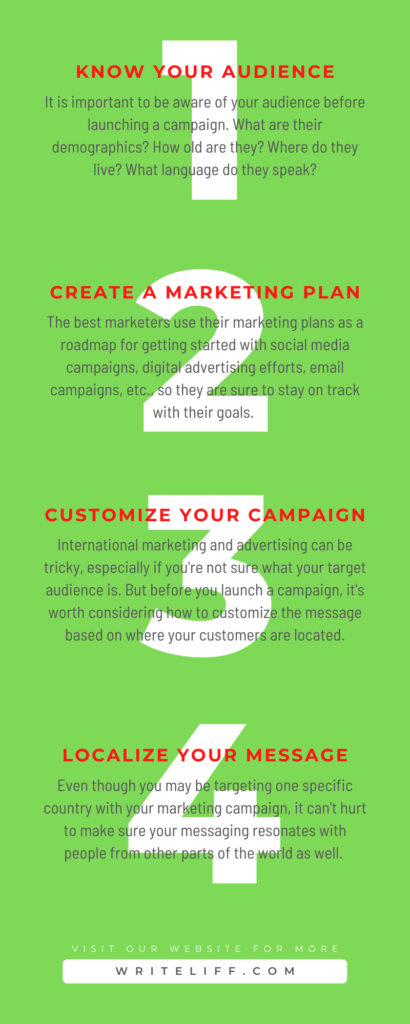How to Launch a Successful Global Marketing Campaign in 4 Steps

Marketing is a tricky subject to get right. It’s not always about the product, but also about who you’re marketing it to and how you market it to them. That’s why we’ve put together this high-level process that will help y you launch your global marketing campaign!
Step #1 Know Your Audience
One of the most important steps in marketing is targeting your audience. Marketers spend hours and hours preparing marketing campaigns.
It is important to be aware of your audience before launching a campaign. What are their demographics? How old are they? Where do they live? What language do they speak? Knowing the answers to these questions will help you find success with your campaign!
Marketers are always trying to stay on top of the latest trends and what’s trending. However, many times marketers forget about their audience when it comes to determining what they should be doing for marketing campaigns. Before launching your next campaign, make sure you know who you’re targeting first!
You need to understand how identifying this group of people can help you determine the best actions for them – whether that be via social media advertising or through other channels. Understanding who you are targeting will also help with creating a message that resonates with them as well!
Step #2 Create a Marketing Plan
International marketing campaigns are complicated. There are so many factors to take into consideration that it can be difficult to know where to start, but if you want your campaign to be successful then you need to do your research and plan ahead.
We know that marketing is one of the most important tasks for any company. Unfortunately, many business owners don’t take the time to create a marketing plan before launching their campaigns.
A marketing plan is a written document that outlines the goals of your campaign, how you’ll measure the success, and the budget. It’s not something to be taken lightly or put together last minute.
The best marketers use their marketing plans as a roadmap for getting started with social media campaigns, digital advertising efforts, email campaigns, etc., so they are sure to stay on track with their goals.
Step #3 Customize Your Marketing Campaign
International marketing and advertising can be tricky, especially if you’re not sure what your target audience is. But before you launch a campaign, it’s worth considering how to customize the message based on where your customers are located.
The different cultures and languages require a lot of planning to make sure our message resonates with the audience.
Before launching your campaign, you need to go through the following list:
- Research how people in the target market communicate
- Consider cultural norms for social media usage
- Determine which languages are appropriate for your content
- Make sure you have access to local talents
- Be aware of country-specific regulations on advertising
- Keep track of time zones so there is no confusion about when someone views or comments on your posts
Step #4 Localize Your Message
Ever wonder how your international marketing message is received by people from other countries? The reason why I ask this question is that it’s really hard to know if you’re being successful or not.
Marketers need to keep in mind that not all consumers are looking for the same things, and some cultures have different values than others.
Even though you may be targeting one specific country with your marketing campaign, it can’t hurt to make sure your messaging resonates with people from other parts of the world as well.
To help you out with this your localization strategy, I created the following list of things that will help you localize your message and brand for international marketing.
- Research the demographics of the target country
- Understand the cultural differences that might affect how people react to different messages or promotions
- Determine what type of language is most commonly spoken in that country
- Keep in mind how different languages will change the meaning of words and phrases
- Use a translator for any written materials, including marketing materials and press releases
- Consider what aspects of your product or service are most important to that culture
- Make sure you have culturally relevant products available for purchase online as well as in stores – this includes things like packaging design, size options, colors, etc.
- Know how to use social media channels specific to that region
- Consider what color palettes are popular in that country – bright colors may be more popular than pastels, for example
- Be mindful of language barriers and consider all aspects of communication, such as tone, gestures, and facial expressions

